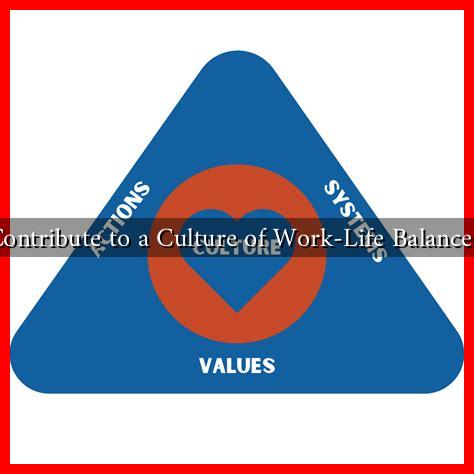-
Table of Contents
How to Contribute to a Culture of Work-Life Balance at Work
In today’s fast-paced work environment, the importance of work-life balance has gained significant attention. Employees are increasingly seeking workplaces that respect their personal time and well-being. A culture of work-life balance not only enhances employee satisfaction but also boosts productivity and reduces turnover rates. This article explores practical ways to contribute to a culture of work-life balance at work, benefiting both employees and employers.
Understanding Work-Life Balance
Work-life balance refers to the equilibrium between professional responsibilities and personal life. Achieving this balance is crucial for mental health, job satisfaction, and overall well-being. According to a survey by the American Psychological Association, 61% of employees reported that work-life balance is a significant factor in their job satisfaction.
Promoting Flexible Work Arrangements
One of the most effective ways to foster a culture of work-life balance is by promoting flexible work arrangements. This can include options such as remote work, flexible hours, and compressed workweeks. Here are some strategies to implement:
- Remote Work: Allow employees to work from home, reducing commute time and providing a comfortable work environment.
- Flexible Hours: Enable employees to choose their working hours, accommodating personal commitments and peak productivity times.
- Compressed Workweeks: Offer the option to work longer hours for fewer days, giving employees extended time off.
Companies like Microsoft Japan have successfully implemented a four-day workweek, resulting in a 40% increase in productivity and happier employees. Such initiatives demonstrate that flexibility can lead to better outcomes for both employees and employers.
Encouraging Time Off and Breaks
Encouraging employees to take regular breaks and utilize their vacation time is essential for maintaining work-life balance. Here are some ways to promote this culture:
- Mandatory Time Off: Implement policies that require employees to take their vacation days to recharge.
- Break Reminders: Use tools or apps that remind employees to take short breaks throughout the day to improve focus and reduce burnout.
- Wellness Programs: Offer wellness initiatives that encourage physical activity, mindfulness, and relaxation techniques.
A study by the U.S. Travel Association found that employees who take vacations are 30% more likely to receive a raise or bonus than those who do not. This statistic highlights the importance of time off for both personal well-being and professional advancement.
Fostering Open Communication
Creating an environment where employees feel comfortable discussing their work-life balance needs is crucial. Open communication can lead to better understanding and support from management. Here are some strategies to enhance communication:
- Regular Check-Ins: Schedule one-on-one meetings to discuss workload, stress levels, and personal commitments.
- Anonymous Feedback Channels: Provide platforms for employees to share their concerns and suggestions without fear of repercussions.
- Training for Managers: Equip managers with the skills to recognize signs of burnout and to support their teams effectively.
Companies like Google have implemented regular feedback sessions, allowing employees to voice their concerns and contribute to a more balanced work environment.
Leading by Example
Leadership plays a pivotal role in establishing a culture of work-life balance. Leaders should model the behavior they wish to see in their teams. Here are some ways leaders can lead by example:
- Respect Boundaries: Avoid sending emails or messages outside of working hours to set a standard for work-life boundaries.
- Share Personal Experiences: Openly discuss the importance of work-life balance and share personal strategies for achieving it.
- Encourage Team Activities: Organize team-building activities that promote relaxation and camaraderie outside of work.
When leaders prioritize their own work-life balance, it sends a powerful message to employees about its importance.
Conclusion
Contributing to a culture of work-life balance at work is a shared responsibility that requires commitment from both employees and employers. By promoting flexible work arrangements, encouraging time off, fostering open communication, and leading by example, organizations can create an environment where employees thrive both personally and professionally. As the workplace continues to evolve, prioritizing work-life balance will not only enhance employee satisfaction but also drive organizational success. For more insights on work-life balance, consider exploring resources from the [American Psychological Association](https://www.apa.org).


